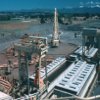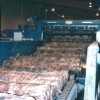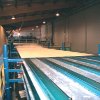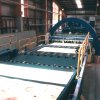Radiata goes to LVL
22 February 2004Before embarking on its new venture in the production of LVL, Nelson Pine Industries Ltd sent radiata pine peeler logs to Japan for peeling and structural property evaluation to determine the suitability of this species for LVL production.
The company identified three key markets for its LVL. Australasia was the first, but as it is comparatively small and has two other large LVL plants already supplying the market, the larger consumers – Japan and the US – were the next two obvious destinations.
Each market requires different product certification: in the Australasian markets, it is AS/NZS 4357, while in Japan it is JAS 1443 and in the US, ASTM D5456. The testing regimes for each standard differ slightly and separate certification is required for each.
In order to gain certification for the three key LVL markets, Nelson Pine became an associate of the Plywood Association of Australasia (PAA), through which it has so far gained certification for the products sold into the Australasian market.
The PAA has worked closely with the Japanese MAFF during the recent changes to the JAS (Japanese Agricultural Standard) laws.
This has enabled the PAA to certify its members for production to JAS standards once all the required criteria have been met.
The PAA is also working with a US certification agency for the US market, using the testing and auditing systems that PAA already has in place with its members.
Having made the decision to make LVL, machinery suppliers were selected.
Raute of Finland supplied the peeling line, complete with veneer stackers, incorporating moisture grading to complement the log preparation section which includes ring debarker, cut-to-length saw and hot water cooking vats.
The LVL plant itself was contracted to Dieffenbacher of Germany and incorporates veneer scarfing and lay-up by Corvallis Tool Company (CTC) of the US and a 45m continuous press with microwave pre-heating.
LVL billets are produced in 1,250mm widths, thicknesses of 12mm to 120mm, and lengths up to 18m.
The Nelson Pine veneer production line was commissioned in September 2002, five months ahead of the LVL production line, with the stepped start-up providing a more even workload for the construction and installation workforce and early cash flow from veneer sales to local and international markets.
The veneer and LVL lines are on separate parts of the site. The veneer line positioning ties in with pre-existing log handling facilities, while chip from green veneer waste and peeler cores can go to the MDF line.
The LVL line, on the opposite side of the site, is right beside the Dynea resin plant, which makes the majority of the adhesives used in the production of Nelson Pine LVL and GoldenEdge MDF.
Selected logs are debarked using a Nicholson 35in A5 Tandem ring, prior to cross-cutting with a bank of five chain saws. The resultant blocks go to collection bins, from which they are transferred to the conditioning vats by overhead gantry cranes.
The blocks are cooked in water for 16-24 hours at 850C to raise their core temperature to a minimum of 550C to improve veneer peel quality while prolonging knife life.
The lathe is a 9ft Raute with laser-controlled XY charger, three-stage chuck, roller nose bar, and power back-up rolls. It is capable of peeling veneer between 2mm and 4.5mm at up to 365m/minute.
The veneer is clipped to width using a Raute rotary clipper controlled by camera scanner. The clipped sheets are automatically graded and stacked by moisture content, measured by a Raute RMS 3000 meter.
The three moisture grades from the green stackers are accumulated for separate drier runs. Reducing the variability of veneer entering the drier by moisture segregation assists in reducing the variability of the dried veneer.
A steam-heated, 50m, six-deck, three-lane veneer dryer was supplied by Babcock BSH, now Grenzebach BSH. It has automated infeed and pack accumulator. The dryer’s length is divided into three temperature-controlled stages and a six metre cooling section, and incorporates an automatic grading and sorting system.
The veneer is dried to a target moisture content of 6%. Another feature of the dryer is that all exhaust gases are ducted to the 20MW energy plant supplied by Easteel of New Zealand. This technique completely eliminates blue haze exhaust from the dryer in the atmosphere.
An Elliot Bay moisture meter and in-house software is used to monitor drier performance and a running tally keeps the operators aware of the re-dry rate. The feed speed of the drier is adjusted if this rate moves outside operating limits.
Additionally, each veneer sheet can be tracked to its deck and lane position in the drier, and a cross-sectional picture built up on the positions in the drier which are being overor under-dried. This information is used in tuning the drier, through jet box modifications by Grenzebach technicians.
The dry veneer sheets are transferred automatically to an automated grading line consisting of a Metriguard 2800 DME ultrasonic stiffness grader, a Babcock Novascan 4000 line camera scanner and an Elliot Bay Cypress 2000 dry chain moisture meter.
The addition of a Metriguard to the grading line was a first for Babcock, but the three components have been integrated successfully. Veneer is automatically machine-graded by a combination of structural and visual characteristics, plus moisture content.
Six structural classes are defined within the Metriguard 2800 DME, based on any combination of modulus of elasticity, ultrasonic propagation time, specific gravity, moisture and width.
Six visual classes are defined within the Novascan computer. Twelve defect types exist, and a visual grade consists of minimum and maximum limits for width, length, area and number for each of these 12 defect types.
The Elliot Bay moisture meter is set up with four moisture classes.
The Novascan holds an eight-grade matrix containing the simultaneous requirement of structural, visual and moisture classes necessary to meet a veneer grade. Six of the eight grades are the user-defined visual grades, one grade is re-dry and the last grade is ‘everything else’.
Using the ability of the Metriguard to spray-mark defined grades, it is also possible to amalgamate two structural grades that have the same visual requirement onto a single stacker. The resultant pack is then segregated later into marked and unmarked sheets.
The graded veneer is automatically stacked on one of nine Babcock stacking tables for the eight grades, plus one floating spare stacker.
The veneer is transferred to the LVL plant, accumulated by grade, then all LVL veneer is scarfed using a CTC scarfer with skew correction and two-bin stacker.
The appropriate grades of scarfed veneer are then placed onto each of 10 CTC veneer feeder line stations according to the grading and the recipe being run. Half the veneer packs are turned over using a CTC pack rotator so that the finished LVL product has alternate tight and loose veneer orientations to assist product stability.
The veneer passes through an Elliot Bay Cross Tipple moisture meter which gives the opportunity to reject overly wet veneer and feeds moisture trends to the press control room so the operators can make adjustments to press or glue-spread parameters if required.
A Koch 1400mm curtain coater is used to coat the sheets with Ready to Use (RTU) Phenol Formaldehyde (PF) adhesive. The RTU is made at Dynea’s neighbouring plant.
The glue-coated veneer continues down the transport conveyor to the Dieffenbacher/CTC automated dual level lay-up station.
Veneers are arranged with the stiffest structural grade on the outside of the lay-up, and the least stiff veneers in the core. Either two or three structural grades will be placed in a structural LVL lay-up.
The laid up veneer billet is then continuously transferred to the press via a 300kW, 924MHz microwave that pre-heats the veneers prior to entry into the continuous press.
The 46.2m Dieffenbacher CPS 150 press has 30 pressure and three heat zones. At the end of the press, the billet passes through an EWS Ultra-Scan ultrasonic 12-head blow detector.
The LVL billet is edge-trimmed to 1258mm wide, which later cools to 1250mm.
The billets are cut in nominated lengths between 6m and 18m with the flying cutoff saw, identified with a traceable pack number and left to cure for a minimum of 24 hours before running on the billet processing line.
Each pack has at least one laboratory sample cut from it during the production process to check bond quality and structural performance and full records are kept.
The packs have an initial quality inspection in the lay-down area where they are checked for over-lap or related quality issues. Once cured these are de-stacked into single billets and cut to length on a Dieffenbacher saw, when any ‘blown’ sections of billet can be rejected.
During the finishing process billets can be sanded using a Steinemann four-head widebelt sander. They then pass through a Paul rip saw which rips them into widths between 90mm and 1230mm.
From log to finished LVL pack, Nelson Pine has quality control measures to ensure greater process efficiency, reduced waste and a better product. Combining this with the comprehensive automated veneer grading system to select the optimal veneers for each product means that Nelson Pine LVL is fast gaining a marketplace reputation for superior product presentation and quality.



